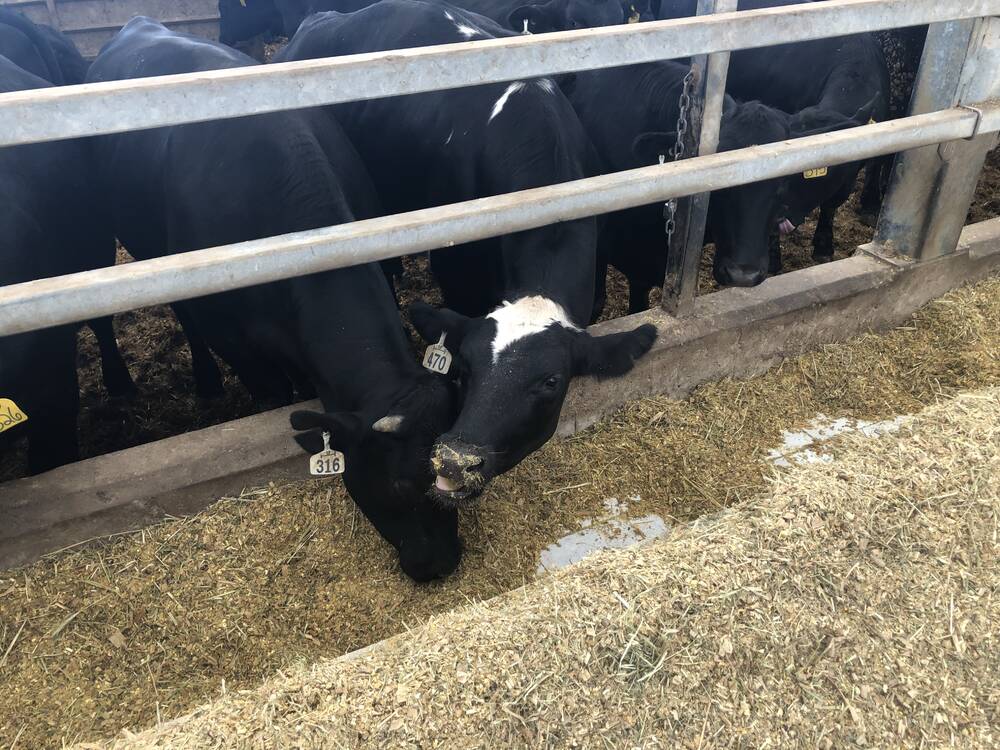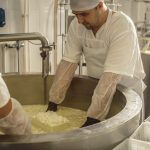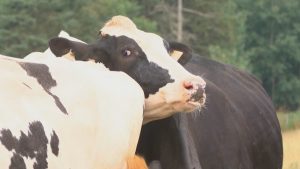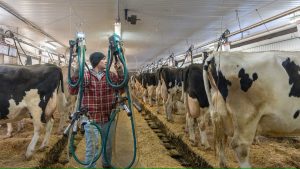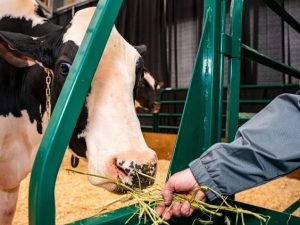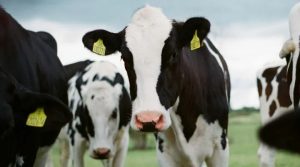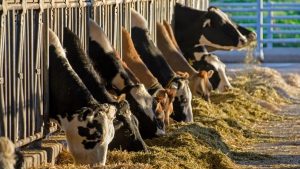
Large increases are seen in price for dairy cows, calves.
The rapid rise in beef cattle prices has driven inflation and fundamental change in the dairy sector.
Similar to the price for beef calves and cows, cull dairy cows, young cross-bred calves destined for the beef market and fresh milking cows have more than doubled in value.
In a rapid change within the dairy sector over the past five years, the best cows and heifers are bred to sexed semen, ensuring higher quality genetic females. The rest of the herd is bred to beef bulls and those offspring are sold into the beef market.
“It went very swiftly from five per cent to now we’re looking at numbers of 30 per cent of the semen being used on dairy farms in Canada is beef semen,” said Michael Steele, a professor in the animal biosciences department at the University of Guelph.
For most dairy farms, the increase in value for dairy cows and crossbred calves is welcome.
Van Dieten Dairy, which runs a conventional dairy farm near Seaforth and an organic dairy near Ethel, has historically sold its bull calves to a local veal grower. Now, the veal grower has shifted much of his business to crossbreds.
“They still get sold at 10 days of age and it’s a market price plus a premium for the beef calves,” said Derek Van Dieten.
The price of veal calves has also stayed high.
Cows have a calf that’s now worth $500 to $1,000 instead of $100. That’s cash in hand for a farmer, without the $3,000 cost of raising that animal to a milking cow. Raising only the needed heifers is also attractive for dairy farmers.
Finding a balance
The challenge is finding the right balance between breeding enough cows for the dairy herd and running short of heifers two years later when they are ready to start milking.
There has been little growth in milk quota in the last two or three years, so there has been little demand for extra heifers. It was better to crossbreed extra animals for beef. A recent slight increase and incentives to produce more milk this fall resulted in even more pressure on fresh cow prices.
There’s a general belief that there is a low number of fresh dairy cows available for purchase in North America and that’s driven up the price of fresh cows significantly.
At the regular fresh cow sale at Carson Farms and Auction Services in Listowel on Sept. 11, 22 cows averaged about $4,000, with several selling for around $5,000. That’s up from $2,500 a few years ago.
Van Dieten said a cull cow is generally sold for about half the cost of a fresh cow, and with cull cow prices now about $2,500, fresh cows sell for about $5,000.
In its annual report on cattle numbers, the United States Department of Agriculture estimated that dairy heifer numbers were at a 20-year low and were down 15 per cent over six years.
Beef cow numbers in the United States and Canada are also down to levels not seen in 60 to 70 years, so there is a strong pull from the marketplace to find beef, and it’s been found in the dairy sector.
Jamie Howard, director of sales with EastGen, said he doesn’t think the numbers will soon change. Beef semen comprises about 30 per cent of EastGen’s units, a dramatic change for a company built on elite Holstein dairy genetics.
“I think to move the price or to move those cattle prices to a lower position, we’d have to see a real uptick of more sexed semen being used and less beef semen being used,” Howard said during an interview at Canada’s Outdoor Farm Show.
“Currently we’re seeing no movement, particularly on the beef side, because the beef calf cheques are very expensive. People are selling the F1 generation calves for quite a bit of money, and that’s a good thing.”
Infrastructure being built
There is a steady trend of dairy animals crossbred for beef. Significant infrastructure is being built to manage the young calves, and feedlots are being built to focus on finishing dairy beef.
Blackshirt Feeders is building a 150,000-head feedlot in Kansas that will finish only dairy-beef animals. The attraction is consistent genetics across the dairy sector and the ability to control the beef side through artificial insemination and partnerships that reach from the feedlot to the dairy.
Dairy beef cattle can be tracked from birth including sire, treatment and performance data. Kee Jim, a well-known Alberta veterinarian who developed the leading feedlot management software system, is involved in managing the Blackshirt Feeders value chain.
He recently spoke at the Canadian Beef Industry Convention in Saskatoon and outlined the value-chain advantages of dairy beef.
“We have a lot of very small herds throughout North America, and trying to get the collaboration between the beef cow producers and the feedlot sector in a meaningful way has proved to be pretty elusive, just related to the structure and the dynamics,” he said.
Jim said the dairy sector has always had an impact on the beef market and dairy steers have accounted for 17 to 22 per cent of North American beef production, in addition to the meat from cull cows. With more dairy crossbreds moving into beef production, he said that number will grow.
Lots to learn
Steele has found that feeding high-energy diets to dairy beef animals post-weaning can result in highly efficient gains and animals ready for processing at 12 months, “which is really incredible and extremely efficient.
“We just reared animals that were Holstein purebred as well as crossbreds in a preliminary study, and these animals were growing at extremely high rates of over 2.5 kilograms per day, and they were finished over 700 kilograms just over 12 months of age,” said Steele.
Increased efficiency of gain also means a lower carbon footprint for beef, he added.
The rapid changes mean there is a lot to learn about the effect of the system on the animals, including anecdotal concerns about liver abscesses, the effect of high-energy diets on younger animals and how to manage their transportation.
Comingling calves into dairy beef nurseries is like bringing children from many homes and disease sources into a daycare, so managing disease also needs research.
Steele and his colleagues are tackling some of these issues at the University of Guelph, but peer-reviewed research is lacking in many of these areas.
For now, the money coming into farmer’s hands is welcome and it’s driving change in both the dairy and beef sectors.
“Is it going to last forever?” asks Steele. “I don’t think it is, because the end price has to be quite high to make any revenue off the newborn calf price. So I think let’s enjoy it while we have it.
“As a dairy producer, you’re going to be generating a lot of income, but pretty soon it will go down to what I think is a little bit more reasonable.” –With files from Melissa Jeffers-Bezan.
You can now read the most important #news on #eDairyNews #Whatsapp channels!!!
🇺🇸 eDairy News INGLÊS: https://whatsapp.com/channel/0029VaKsjzGDTkJyIN6hcP1K
